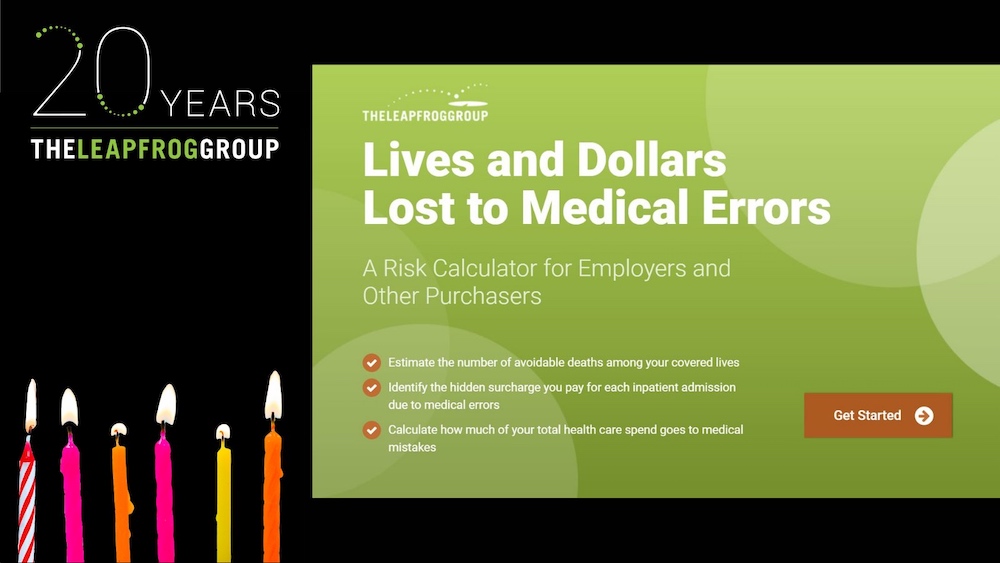The Leapfrog Group’s ‘Lives & Dollars Lost Calculator’ Shows Cost of Ignoring Medical Errors
Healthcare simulation can help prevent clinical mistakes, yet more than 250,000 people are estimated to die annually from preventable medical errors. When mistakes occur, employers pay the price in human lives and dollars. To demonstrate the risk of medical errors , The Leapfrog Group developed a “Lives & Dollars Lost Calculator.” This free resource is a way for employers to assess the toll that medical errors have on their employee population.
“Prior to COVID-19, medical error was the third leading cause of death in the United States, behind cancer and heart disease. People need to be aware that this is an issue, but also know that there are many facilities that are better than others at protecting their patients from these errors,” said Erica Mobley, vice president of administration at The Leapfrog Group. “By sharing information on that, we can hopefully help people find better healthcare for themselves and their families.”
By using the Lives & Dollars Lost Calculator, employers and purchasers can estimate the number of avoidable deaths among their covered lives, and identify the hidden surcharge paid for each inpatient admission. The calculator also allows them to calculate how much of their total healthcare spending goes toward medical mistakes.
Sponsored Content:
“We have known for a long time that there is a tremendous financial and human toll due to medical errors that happen in hospitals. A lot of the expense of this is felt by employers, meaning companies that provide health benefits to their employees,” Mobley added. “We wanted to find a way to help employers recognize what this truly means to an employer’s population to help them recognize the scope of the problem. From there, they can hopefully take steps to improve [upon the problem].”
To be able to accurately utilize the Lives & Dollars Lost Calculator, facilitators must have access to the total number of inpatient admissions at their respective facility within the United States spanning a full calendar year. They should be aware of the current Leapfrog Hospital Safety Grades (A, B, C, D or F) for the facility their employees utilize. Additional requirements include obtaining the estimated percent of admissions that require surgery or an ICU stay, and the estimated total expenses for healthcare coverage.
“We’ve received very positive feedback [from employers]. Most employers that have used [the calculator] say that it’s tremendously eye-opening to them, and that they didn’t previously have a good sense of how much they spent due to medical errors,” Mobley said. “People have given us very strong feedback saying that [the calculator] has raised their awareness to an issue that they did not previously have much knowledge of.”
Sponsored Content:
With these systematic benefits in mind. The Leapfrog Group provides the Lives & Dollars Lost Calculator at no cost as a public service. The calculator is fully transparent, and includes an optional download which contains the full formulas, assumptions and sources behind our calculations. To run the calculator, employers may need to work with their health insurer or third-party administrator (TPA) to determine their company’s information in COLUMN G.
“It’s used by employers who want to understand the potential risk and exposure of their employee population as a whole. In general, we have seen an increased use of the calculator and we have certainly been working with employer organizations and others to encourage them to make people aware that it is a totally free tool,” Mobley explained. “Anyone can come to our website and use the Lives & Dollars Calculator.”
See how Leapfrog’s Lives & Dollars Lost Calculator helps employers save money & lives: https://t.co/F3nD9tK8wi #ptsafety #LeapfrogTurns20 pic.twitter.com/j2g8whyX36
— The Leapfrog Group (@LeapfrogGroup) November 17, 2020
More About The Leapfrog Group
Founded in 2000, the Leapfrog Group is a nonprofit watchdog organization that serves as a voice for healthcare consumers and purchasers by using their collective influence to foster positive change in United States healthcare. Headquartered in Washington D.C., Leapfrog is an advocate of transparency in healthcare — collecting, analyzing and disseminating data to inform value-based purchasing and improved decision-making.
The company’s mission is to trigger giant leaps forward in the safety, quality and affordability of U.S. healthcare by using transparency to support informed healthcare decisions and promote high-value care. To help achieve this mission, the flagship Leapfrog Hospital Survey collects and transparently reports hospital performance, empowering purchasers to find the highest-value care and giving consumers the lifesaving information they need to make informed decisions. The Leapfrog Hospital Safety Grade, Leapfrog’s other main initiative, assigns letter grades to hospitals based on their record of patient safety, helping consumers protect themselves and their families from errors, injuries, accidents and infections.
The Leapfrog Group envisions a future where purchasers will tie healthcare investment to excellence and educate their employees on choosing the best care. Health plans will support purchasers in their efforts to reward high performance and to empower employees. Consumers will fight for the best care for themselves and their families. Providers will be courageous in championing transparency and leading groundbreaking improvements. By living The Leapfrog Group’s vision, providers will work to give the next generation the safest, highest-quality healthcare system in the world.
Healthcare Simulation Proven to Reduce Errors and Save Costs
One Simulation in Healthcare Journal research publication entitled “Cost Savings From Reduced Catheter-Related Bloodstream Infection After Simulation-Based Education for Residents in a Medical Intensive Care Unit” (Cohen, Elaine R. BA; Feinglass, Joe PhD; Barsuk, Jeffrey H. MD; Barnard, Cynthia MBA, MSJS; O’Donnell, Anna RN, BSN; McGaghie, William C. PhD; Wayne, Diane B. MD) which utilized CentraLineMan found that “A simulation-based educational intervention in CVC insertion was highly cost-effective… at a Return-Of-Investment ratio of 7:1 with a cost savings of over $700,000 dollars for the hospital”.
With an “ounce of prevention worth a pound of cure”, Simulation-Based Training (SBT) can reduce long-term costs by reducing costly medical errors!
Learn More About The Leapfrog Group
Lance Baily, BA, EMT-B, is the Founder & CEO of HealthySimulation.com, which he started while serving as the Director of the Nevada System of Higher Education’s Clinical Simulation Center of Las Vegas back in 2010. Lance is also the Founder and acting Advisor to the Board of SimGHOSTS.org, the world’s only non-profit organization dedicated to supporting professionals operating healthcare simulation technologies. His co-edited Book: “Comprehensive Healthcare Simulation: Operations, Technology, and Innovative Practice” is cited as a key source for professional certification in the industry. Lance’s background also includes serving as a Simulation Technology Specialist for the LA Community College District, EMS fire fighting, Hollywood movie production, rescue diving, and global travel. He and his wife Abigail Baily, PhD live in Las Vegas, Nevada with their two amazing daughters.
Sponsored Content:




















